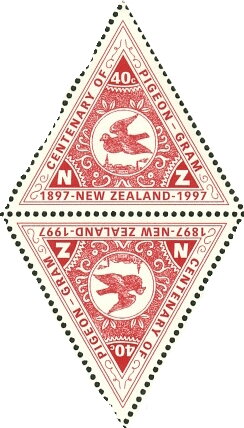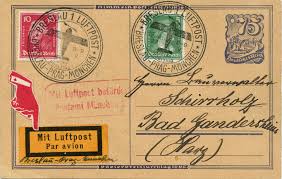Tete-Beche: Pigeon-gram (New Zealand 1997)
Pigeon-gram (New Zealand 1997)
07 May (New Zealand ) within release Centenary of Pigeon-Gram goes into circulation Tete-Beche Pigeon-gram face value 2*40 New Zealand cent
| Tete-Beche Pigeon-gram in catalogues | |
|---|---|
| Unificato: | Un: NZ 1655tb |
Tete-Beche is vertical format.
Also in the issue Centenary of Pigeon-Gram:
- Stamp - Scarlet face value 40;
- Stamp - Deep Dull Blue face value 80;
- Tete-Beche - Pigeon-gram face value 2*40;
- Tete-Beche - Pigeon-gram face value 2*80;
Tete-Beche Pigeon-gram it reflects the thematic directions:
The homing pigeon, also called the mail pigeon or messenger pigeon, is a variety of domestic pigeons (Columba livia domestica) derived from the wild rock dove, selectively bred for its ability to find its way home over extremely long distances. The rock dove has an innate homing ability, meaning that it will generally return to its nest using magnetoreception. Flights as long as 1,800 km (1,100 miles) have been recorded by birds in competitive pigeon racing. Their average flying speed over moderate 965 km (600 miles) distances is around 97 km/h (60 miles per hour) and speeds of up to 160 km/h (100 miles per hour) have been observed in top racers for short[clarification needed] distances.
Columbidae (/kəˈlʌmbɪdiː/ kə-LUM-bih-dee) is a bird family consisting of doves and pigeons. It is the only family in the order Columbiformes. These are stout-bodied birds with short necks and short slender bills that in some species feature fleshy ceres. They primarily feed on plants, and can be taxonomically divided amongst granivores, that feed mostly on the ground on seeds, and frugivores, that feed mostly on fruits, from branches. The family occurs worldwide, often in close proximity with humans, but the greatest variety is in the Indomalayan and Australasian realms.
Postal history is the study of postal systems and how they operate and, or, the study of the use of postage stamps and covers and associated postal artifacts illustrating historical episodes in the development of postal systems. The term is attributed to Robson Lowe, a professional philatelist, stamp dealer and stamp auctioneer, who made the first organised study of the subject in the 1930s and described philatelists as "students of science", but postal historians as "students of humanity". More precisely, philatelists describe postal history as the study of rates, routes, markings, and means (of transport).
The Kionga Triangle (German: Kionga-Dreieck, Portuguese: Triângulo de Quionga) was a small region of German East Africa situated at the mouth of the Ruvuma River. The Ruvuma served as the border between the German colony and Portuguese Mozambique, and the Kionga Triangle was the only section of German East Africa south of the river. Its principal settlement was Kionga (now Quionga ) which had a population of 4,000 in 1910. It became a German possession in 1894 but came under Portuguese control in April 1916 during World War I. The post-war Treaty of Versailles reaffirmed that the river was the border between Tanganyika, then under British control, and Portuguese Mozambique. The triangle was the only territory that the treaty awarded to Portugal.



